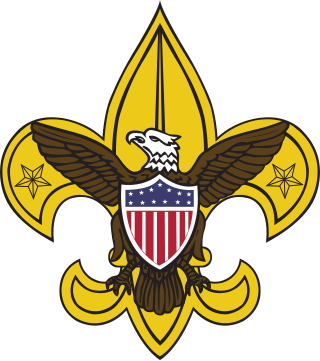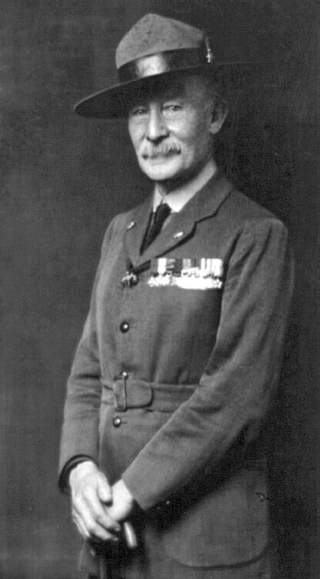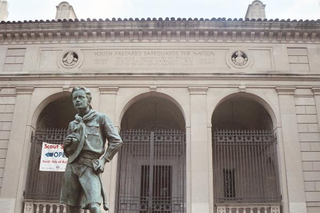
Scouting, also known as the Scout Movement, is a worldwide youth social movement employing the Scout method, a program of informal education with an emphasis on practical outdoor activities, including camping, woodcraft, aquatics, hiking, backpacking, and sports. Another widely recognized movement characteristic is the Scout uniform, by intent hiding all differences of social standing in a country and encouraging equality, with neckerchief and campaign hat or comparable headwear. Distinctive uniform insignia include the fleur-de-lis and the trefoil, as well as merit badges and other patches.

The Boy Scouts of America is one of the largest scouting organizations and one of the largest youth organizations in the United States, with about 762,000 youth participants. The BSA was founded in 1910; about 110 million Americans have participated in its programs. BSA became a founding member organization of the World Organization of the Scout Movement in 1922.

The Order of the Arrow (OA), previously known as Wimachtendienk Wingolauchsik Witahemui (WWW) is the honor society of the Boy Scouts of America (BSA), composed of Scouts and Scouters who best exemplify the Scout Oath and Law in their daily lives as elected by their peers. Started as a Camp Fraternity by E. Urner Goodman, with the assistance of Carroll A. Edson, in 1915, its goal was to reinforce the Scout Oath and the Scout Law. Started without approval of Boy Scouts of America (BSA), it became an "Official Experiment" of the scouting organization. In 1948, following an extensive review, it officially became a program of Boy Scouts of America.

Eagle Scout is the highest rank attainable in the Scouts BSA program by the Boy Scouts of America (BSA). Since its inception in 1911, only four percent of Scouts have earned this rank after a lengthy review process. The Eagle Scout rank has been earned by over 2.5 million youth.

Cub Scouting is part of the Scouting program of the Boy Scouts of America (BSA), available to boys and girls from kindergarten through fifth grade, or 5 to 10 years of age and their families. Its membership is the largest of the five main BSA divisions. Cub Scouting is part of the worldwide Scouting movement and aims to promote character development, citizenship training, personal fitness, and leadership.

A variety of religious emblems programs are used by the Boy Scouts of America (BSA) to encourage youth to learn about their faith and to recognize adults who provide significant service to youth in a religious environment. These religious programs are created, administered and awarded by the various religious groups, not the BSA, but each program must be recognized by the BSA.
The Boy Scouts of America (BSA), one of the largest private youth organizations in the United States, has policies which prohibit those who are not willing to subscribe to the BSA's Declaration of Religious Principle, which has been interpreted by some as banning atheists, and, until January 2014, prohibited all "known or avowed homosexuals", from membership in its Scouting program. The ban on adults who are "open or avowed homosexuals" from leadership positions was lifted in July 2015.

William Hillcourt, known within the Scouting movement as "Green Bar Bill", was an influential leader in the Boy Scouts of America (BSA) organization from 1927 to 1992. Hillcourt was a prolific writer and teacher in the areas of woodcraft, troop and patrol structure, and training; his written works include three editions of the BSA's official Boy Scout Handbook, with over 12.6 million copies printed, other Scouting-related books and numerous magazine articles. Hillcourt developed and promoted the American adaptation of the Wood Badge adult Scout leader training program.

James Edward West was a lawyer and an advocate of children's rights, who became the first professional Executive Secretary, soon renamed Chief Scout Executive, of the Boy Scouts of America (BSA), serving from 1911 to 1943. Upon his retirement from the BSA, West was given the title of Chief Scout.

Scouts BSA is the flagship program and membership level of the Boy Scouts of America (BSA) for boys and girls between the ages of typically 11 and 17. It provides youth training in character, citizenship, and mental and personal fitness. Scouts are expected to develop personal religious values, learn the principles of American heritage and government, and acquire skills to become successful adults.
Lone Scouts of America (LSA) was a Scouting organization for American boys that operated from 1915 until it merged with the Boy Scouts of America (BSA) in 1924. The LSA was founded by W. D. Boyce, publisher of the Chicago Ledger and the Saturday Blade and one of the founders of the BSA. Boyce felt that the program of the BSA did not help the rural boy who could not find enough other boys to form a troop or a patrol. James E. West, the first Chief Scout Executive of the BSA, disagreed with Boyce's concept, believing that the 4-H program was fulfilling the role. After Boyce left the BSA, he started the Lone Scouts of America and incorporated it on January 9, 1915. Boyce became the executive officer or Chief Totem and Frank Allan Morgan became the editor of The Lone Scout. In October 1915, Boyce appointed all of his paperboys as members of the LSA and published the first issue of The Lone Scout magazine.

Scouts' Day or Guides' Day is a generic term for special days observed by members of the Scouting movement throughout the year. Some of these days have religious significance, while others may be a simple celebration of Scouting. Typically, it is a day when all members of Scouting will re-affirm the Scout Promise.

Scouting in the United States is dominated by the 1.2 million-member Boy Scouts of America and the Girl Scouts of the USA and other associations that are recognized by one of the international Scouting organizations. There are also a few smaller, independent groups that are considered to be "Scout-like" or otherwise Scouting related.

The Boy Scouts of America (BSA) was inspired by and modeled on The Boy Scouts Association, established by Robert Baden-Powell in Britain in 1908. In the early 1900s, several youth organizations were active, and many became part of the BSA.

Religion in Scouting and Guiding is an aspect of the Scout method that has been practiced differently and given different interpretations in different parts of the world over the years.

Learning for Life (LFL) is a United States school and work-site based youth program that is an affiliate of the Boy Scouts of America. It utilizes programs designed for schools and community-based organizations that are designed to prepare youth for the complexities of contemporary society and to enhance their self-confidence, motivation, and self-esteem, and for careers.

Scouting and Guiding in India have a long history.

The Boy Rangers of America was a Scouting program in the United States for boys ages 8 through 12. It was organized on January 24, 1913 in Montclair, New Jersey by Emerson Brooks. Although independent of the Boy Scouts of America, it was the precursor of the BSA's Cubbing program now known as Cub Scouting.
Besides the Boy Scouts of America (BSA) and Girl Scouts of the USA, both of which still exist, there were other Scouting and Scout-like organizations that arose over the years in the United States. Many are now defunct, including these examples.















